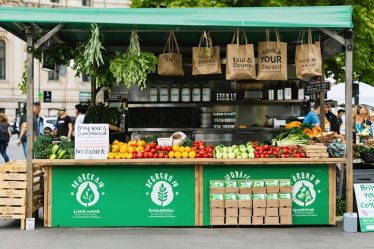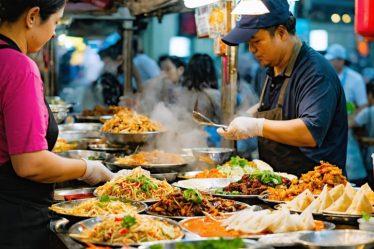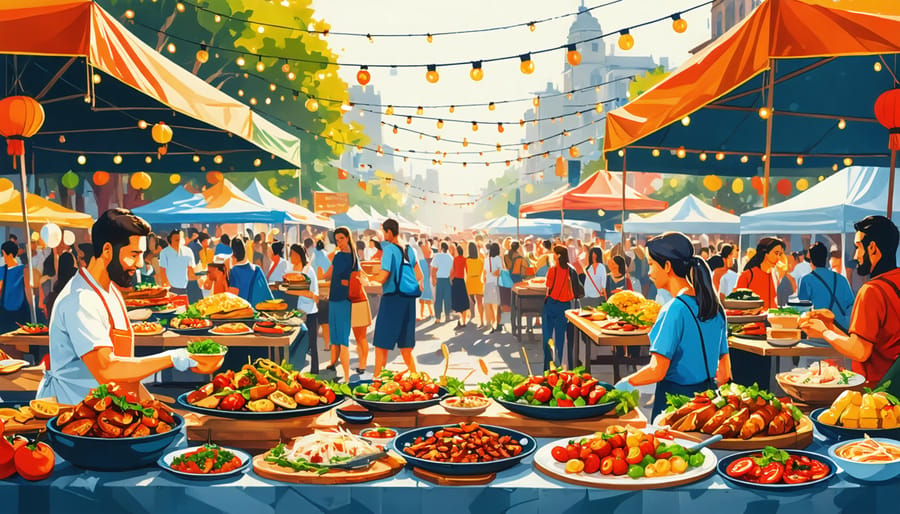
Step into a world where aromas tell ancient stories and flavors bridge generations at cultural food festivals – vibrant celebrations where cultural heritage through food comes alive on bustling streets and community squares. From the sizzling tteokbokki at Seoul’s Gwangjang Market to the aromatic paella at Barcelona’s La Mercè, these gatherings transform ordinary neighborhoods into extraordinary feasts of tradition and innovation.
I’ll never forget my first night market experience in Taipei, where the simple act of sharing stinky tofu with strangers turned into an impromptu cultural exchange that transcended language barriers. These festivals aren’t just about satisfying hunger – they’re living museums where recipes passed down through generations tell stories of migration, resilience, and celebration.
Whether you’re a curious food explorer or a seasoned culinary adventurer, cultural food events offer a unique window into the heart of communities worldwide. They’re where grandmothers’ secret recipes meet modern food trends, where traditional cooking methods are preserved, and where the simple act of breaking bread together creates bonds that last a lifetime.
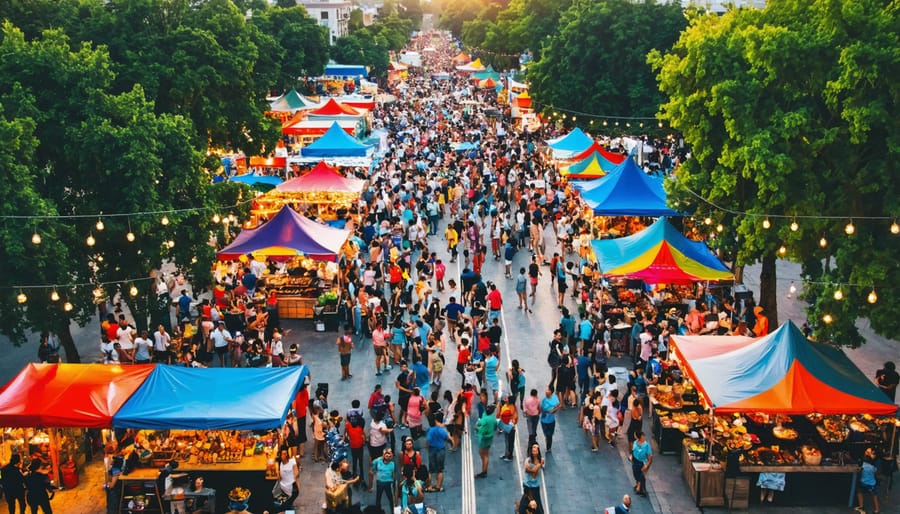
The Magic of Cultural Street Food Festivals
More Than Just Food
When you step into a cultural food festival, you’re entering a world where unique culinary experiences blend seamlessly with vibrant traditions. The aroma of sizzling dishes mingles with the sound of traditional music, creating an atmosphere that feeds all your senses. Watch as skilled dancers perform centuries-old routines, their colorful costumes swirling to the rhythm of authentic instruments. Many festivals feature live demonstrations of traditional crafts, from intricate paper cutting to pottery making, offering glimpses into the artistic heritage that shapes these cultures.
Children often gather around storytellers who share tales passed down through generations, while artisans display handmade jewelry and textiles that reflect their cultural identity. The joy of these events lies in their ability to create connections – between past and present, between different communities, and between people who might otherwise never meet. It’s this combination of food, art, and tradition that transforms a simple meal into a celebration of human creativity and cultural pride.
A Feast for All Senses
Cultural food festivals are a symphony for all your senses, creating an unforgettable atmosphere that goes far beyond just taste. The moment you step into these vibrant gatherings, you’re enveloped by the aromatic clouds of sizzling spices and fresh herbs that dance through the air. I’ll never forget my first Asian night market experience, where the sweet scent of grilled yakitori mingled with the earthy aroma of freshly steamed dumplings.
The visual feast is equally captivating, with colorful food stalls decorated in traditional motifs, strings of twinkling lights overhead, and the mesmerizing sight of skilled vendors preparing dishes with practiced precision. The sizzle of a hot griddle, the cheerful chatter of fellow food lovers, and often the enchanting sounds of live cultural music create an audio landscape that transforms a simple meal into an immersive experience.
What makes these events truly special is the tactile experience – the warmth of a freshly made tortilla, the crunch of Vietnamese spring rolls, or the comfort of holding a steaming bowl of ramen. It’s these sensory details that turn a simple food festival into a memorable cultural celebration that stays with you long after the last bite.
Stories Behind the Stalls
Family Traditions on Display
At the heart of every cultural food event lies a tapestry of family stories, passed down through generations alongside cherished traditional cooking methods. Watching vendors prepare their specialties is like stepping into their family kitchens, where grandmothers once taught their children the perfect way to fold dumplings or the secret to achieving that perfect spice blend.
Take Maria, who brings her grandmother’s tamale recipe to life at local festivals. Using the same wooden spoon that’s been in her family for decades, she carefully layers masa and filling just as she was taught as a child. Nearby, the Chang family demonstrates the art of hand-pulling noodles, their synchronized movements a testament to years of practice and family dedication.
These vendors don’t just serve food; they share their heritage through every dish they prepare. From the way they arrange their stalls with family photos and cultural artifacts to their willingness to explain the significance behind each ingredient, they create meaningful connections with festival-goers. It’s these personal touches and family stories that transform a simple food stall into a window into another culture, making each bite a journey through generations of tradition.
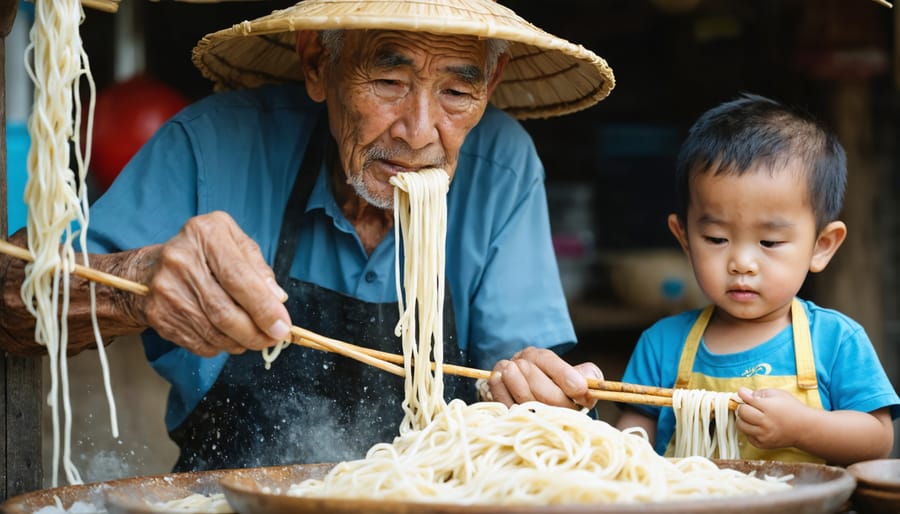
Modern Twists on Classic Dishes
The culinary landscape is evolving as younger generations breathe new life into time-honored recipes, creating exciting fusions that honor their heritage while embracing contemporary tastes. I recently attended a food festival where a Korean-American chef served her grandmother’s kimchi recipe in tacos, perfectly capturing this delicious intersection of tradition and innovation.
Today’s food innovators are finding creative ways to make traditional dishes more accessible and appealing to modern palates. Think quinoa-stuffed grape leaves, cauliflower-crust pizza margherita, and matcha-infused tiramisu. These adaptations often incorporate plant-based alternatives, gluten-free options, and healthier cooking methods while maintaining the essence of the original dishes.
Social media has played a huge role in this evolution, with food creators sharing their modern interpretations and family recipes with global audiences. What’s particularly heartwarming is seeing how these innovations often bring different generations together in the kitchen, creating new memories while preserving cultural connections.
The best part? These creative twists are making traditional cuisines more approachable for those who might have found certain flavors or ingredients intimidating, while still respecting the cultural significance behind each dish. It’s not about replacing traditions – it’s about extending their legacy into the future.
Making the Most of Your Festival Visit
Planning Your Culinary Adventure
Making the most of a cultural food event starts with smart planning. I learned this the hard way at my first street food festival when I arrived too late and missed out on some amazing dishes that had already sold out!
Timing is everything – aim to arrive early, ideally within the first hour of opening. This ensures you’ll have access to all the vendors and shorter lines. Many popular dishes tend to sell out by mid-afternoon, especially at busy festivals.
Come prepared with these essentials: comfortable walking shoes, cash (though many vendors now accept cards), hand sanitizer, and a reusable water bottle. I always bring a small collapsible container for leftovers and a compact umbrella – you never know when you might need them!
To maximize your tasting adventure, gather a group of friends and implement the “divide and share” strategy. Each person can queue at different stalls and purchase different dishes to share. This way, you’ll sample more varieties without getting too full or spending too much.
Start with smaller portions and pace yourself. I recommend beginning with lighter dishes and working your way up to heartier ones. Take breaks between tastings to truly savor each flavor and prevent palette fatigue. Consider keeping a notes app handy to remember your favorites for future visits.
Remember to check the event’s website beforehand for any special requirements or restrictions, and don’t forget to bring your curiosity and enthusiasm for discovering new cuisines!
Engaging with Vendors
One of the most enriching aspects of international food celebrations is the opportunity to connect with the talented vendors who bring their cultural heritage to life through food. Don’t be shy about striking up conversations with the vendors – most are delighted to share stories about their dishes and traditions. I’ve found that asking simple questions like “What makes this dish special in your culture?” or “Is this something you grew up eating?” can lead to fascinating conversations and deeper appreciation of the food.
Remember to show genuine interest and respect when engaging with vendors. Take a moment to observe their preparation techniques, and if it’s not too busy, ask about specific ingredients or cooking methods. Many vendors have fascinating family histories tied to their recipes, passed down through generations.
Consider taking notes on your phone about the vendors you meet and their specialties. This not only helps you remember their stories but also makes it easier to find them at future events. Follow their social media accounts or grab their business cards – many vendors also run restaurants or catering services you might want to support later.
Timing is key when approaching vendors. Mid-morning or mid-afternoon, when the crowds are thinner, are usually better times for meaningful conversations. And don’t forget to express your appreciation – a sincere compliment about their food can brighten their day and strengthen community connections.
Notable Street Food Festivals Worth Traveling For
Local Treasures
Every corner of our country has its own delicious story to tell, and nowhere is this more evident than at our vibrant regional street food festivals. Take Portland’s famous Food Cart Festival, where over 600 food carts gather to create a mouthwatering maze of international flavors. The festival perfectly captures Portland’s quirky spirit, with everything from Korean-Mexican fusion tacos to artisanal vegan ice cream.
Down in New Orleans, the French Quarter Festival isn’t just about jazz – it’s a celebration of Creole and Cajun cuisine that brings together local food vendors serving up authentic gumbo, jambalaya, and beignets. I’ll never forget the first time I tried a properly dressed po’boy while swaying to live jazz on Bourbon Street!
The Taste of Chicago holds the crown as the world’s largest food festival, transforming Grant Park into a culinary paradise each July. Local favorites like deep-dish pizza and Chicago-style hot dogs share the spotlight with diverse offerings from the city’s numerous ethnic neighborhoods.
For something truly unique, the Gilroy Garlic Festival in California celebrates all things garlic, featuring creative dishes like garlic ice cream and garlic-infused cocktails. The festival’s famous Gourmet Alley, run by local volunteers, serves up garlic-forward dishes that have become legendary among food enthusiasts.
What makes these festivals truly special isn’t just the food – it’s the people behind the stalls, the generations-old recipes, and the pride each community takes in sharing their culinary heritage. Whether you’re sampling lobster rolls at Maine’s Lobster Festival or discovering new takes on tacos at Austin’s Food Truck Festival, these events offer a delicious window into the heart and soul of America’s diverse food culture.
Remember to check festival dates well in advance, as many of these popular events sell out quickly. Some even offer early-bird tickets with special perks like VIP tastings or cooking demonstrations.
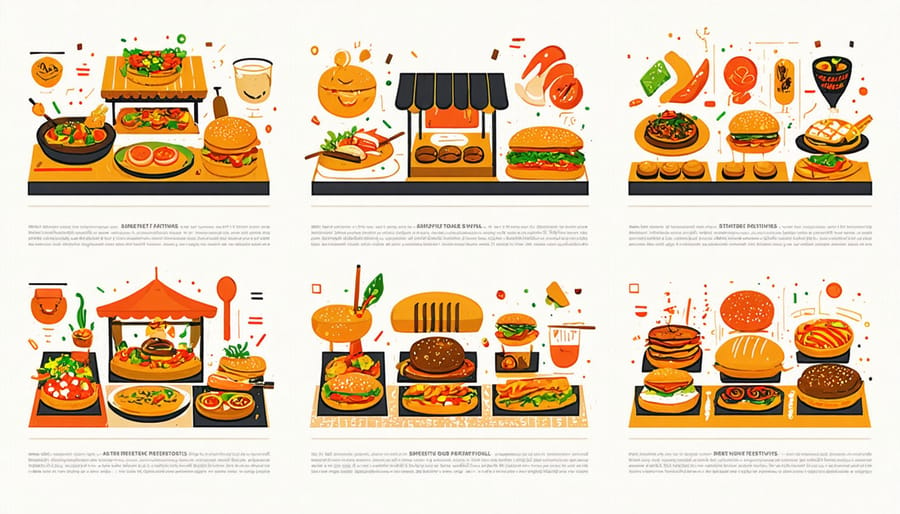
International Food Festivals
Picture yourself wandering through vibrant streets filled with sizzling grills, aromatic spices, and the joyful chatter of food lovers from around the world. International food festivals are where culinary dreams come true, and I’ll never forget my first experience at Singapore’s World Street Food Congress, where the harmonious blend of traditional recipes and modern twists left me completely mesmerized.
These global celebrations of street food culture have become must-visit destinations for food enthusiasts. The Night Noodle Markets in Sydney transform the city’s Hyde Park into an Asian food lover’s paradise each October, featuring everything from traditional Vietnamese pho to innovative fusion dishes. Meanwhile, Copenhagen’s Street Food Festival showcases Nordic cuisine alongside international favorites, proving that street food knows no boundaries.
One of my personal favorites is Mexico City’s Feria del Taco, where local vendors share generations-old family recipes alongside creative new interpretations of this beloved street food. The atmosphere is electric, with live music, cooking demonstrations, and the warmth of community bringing people together through food.
For those seeking authenticity, Bangkok’s World Street Food Festival offers an unparalleled experience. Here, you’ll find everything from perfectly grilled satay to delicate dim sum, all prepared by master street food chefs who’ve perfected their craft over decades.
What makes these festivals truly special isn’t just the food – it’s the stories behind each dish, the passionate vendors who prepare them, and the way they bring people together. Whether you’re a seasoned foodie or just beginning your culinary adventure, these festivals offer a delicious window into different cultures and traditions.
For first-time festival-goers, I always recommend starting with smaller regional events before diving into larger international celebrations. This helps you develop your festival navigation skills while discovering local flavors that might surprise you.
Cultural food events are more than just delightful gatherings where we sample delicious dishes – they’re living museums of our collective heritage, connecting us to traditions that might otherwise fade away. Every time we support a local food festival or cultural celebration, we’re helping to preserve recipes, techniques, and stories that have been passed down through generations.
I’ll never forget watching my grandmother’s eyes light up at a Greek festival last year when she tasted a traditional pastry she hadn’t eaten since childhood. These moments remind us that food is a powerful bridge between past and present, between different cultures and communities.
By participating in these events, whether as attendees, volunteers, or vendors, we become part of a larger story. We help local communities thrive, support small businesses and family-run operations, and ensure that traditional cooking methods and recipes continue to be celebrated and shared with future generations.
Let’s make a conscious effort to seek out and support these cultural food events in our communities. Share them on social media, bring friends and family along, and take the time to learn the stories behind the dishes. Every plate of food at these festivals carries a piece of someone’s history, and by celebrating these events, we’re helping to keep these precious cultural traditions alive and vibrant for years to come.

